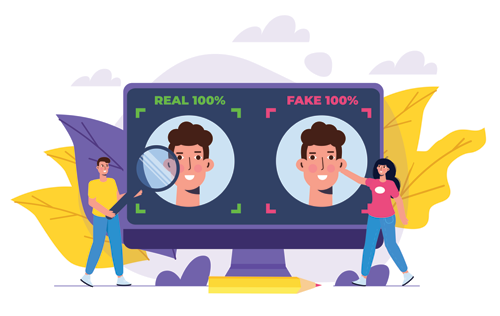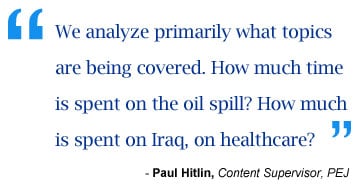We live in a time when technology rules everything around us, and, for the most part, it has helped all of us live better lives. It has done everything from keeping us connected to making us healthier, but one of the most significant changes technology has brought is how we consume our news. Now, more than ever, people are getting their news from video sources, which is fantastic because it allows more information to be shared in condensed chunks.
Getting in Deep: The Cost and Danger of Deepfakes in the Media and Beyond
Misinformation Madness: Can We Trust The News?
Determining which news stories are misinformation versus which are fair and accurate is a challenging task. Fact checking -- which used to be the sole responsibility of news outlets, is beginning to fall on the shoulders of the audience. In today’s flood of misinformation, ensuring the veracity of news content and sources is more critical than ever.
How COVID-19 Impacted News Consumption
There’s no doubt that the world at large has changed drastically since March 2020. With COVID-19 sweeping the globe, change has become the constant in our lives. Work became remote, people became quarantined, businesses suffered, and news media consumption took several interesting turns.
The Best in #jschool Blogging
Modern journalism is a tough business that's rapidly changing. The internet is still trying to make the distinction between a journalist and a blogger, so finding truly insightful, thought-provoking content can be difficult. The following are just a few of the journalists and organizations that we believe are helping to shape the future of journalism.
GIF the debates and the fun never stops!
The 2016 presidential election cycle has been as unpredictable as any election in recent memory with over 20 sanctioned debates, numerous “town hall” discussions and countless candidate speeches. News organizations have been overwhelmed with an unprecedented volume of visual content to share with their viewers.
While debates have been broadcast on television since 1960 (the famous Kennedy-Nixon debates), there has been a seismic shift in the way the presidential debates have been covered in the media this election cycle. The New York Times said it best: political GIFs have become the new sound bites of the 2016 campaign season.
Well this is just a tremendous GIF. #BenghaziCommittee pic.twitter.com/Bnpi6rcQ43
— Dan Zak (@MrDanZak) October 22, 2015
Next up! Journalism Interactive at the University of Florida
Getting Interactive
Tomorrow SnapStream will be participating at Journalism Interactive 2013, a new conference focused on intertwining journalism education and digital media. Host of the second annual event, the University of Florida houses one of the top 10 journalism schools in the country.
Scholars, practitioners, teachers and students, from universities near and far, will congregate at Journalism Interactive to share their successful approaches for delivering journalism education in today's metamorphic media space.
TV Search in Journalism at Emerson College (Webinar Jan. 26)
| Folks, a tremendous peer-to-peer learning opportunity is on the horizon. Joining us from Emerson College in the heart of Boston, Journalism Professor Paul Niwa hosts an exclusive webinar with SnapStream on Wednesday, January 26. |
Talking with Paul Hitlin, Project for Excellence in Journalism
Keeping our good word and following up from this previous post, we're giving you the replay of our J-School webinar featuring Content Supervisor Paul Hitlin at the Project for Excellence in Journalism.
Customer spotlight: Project for Excellence in Journalism analyzes news with SnapStream
Publishing widely regarded content analysis, the Project for Excellence in Journalism serves an important role: keeping the industry in check.
What is SnapStream? There's an unlimited amount of video content out there: 24/7 news channels, breaking news events, sports, talk shows, awards galas, entertainment shows, and so much more.
SnapStream makes a real-time news and media search engine that makes it fast and easy to find the video moments that support our customers telling great stories.
Posts by Topic
- General TV Search (165)
- Technology Development (28)
- Support Corner (26)
- Television and Film Production (26)
- Social TV (24)
- Broadcast Monitoring (23)
- TV Trends (23)
- Tradeshows (23)
- news (23)
- Government (19)
- Release (19)
- Fun (16)
- Journalism (16)
- Politics (16)
- TV search (16)
- Education (14)
- Newsmedia (13)
- new product (13)
- updates (13)
- Entertainment (11)
- Video Clips (10)
- broadcast compliance (10)
- broadcast monitoring and compliance (10)
- social engagement (10)
- Twitter TV clips (8)
- Local TV stations (7)
- TV Monitoring/PR (7)
- Meet Team SnapStream (6)
- SnapStream News (6)
- Social in Sports (6)
- social sharing (6)
- livecut (5)
- City Government (4)
- International (4)
- Sports (4)
- media monitoring (4)
- snappytv (4)
- thought leadership (4)
- Addressable Advertising (3)
- CALM Act (3)
- Case Study (3)
- Context (3)
- Facebook TV clips (3)
- LKFS (3)
- Resources (3)
- SnapStream Cloud (3)
- SnapStream Enterprise (3)
- Streams (3)
- TV closed-captioning search (3)
- avoidance (3)
- clipping (3)
- ditigal (3)
- loudness compliance (3)
- misinformation (3)
- snappytv alternative (3)
- snappytv replacement (3)
- television monitoring (3)
- 8.3 (2)
- 8.5 (2)
- Advertising (2)
- How-to (2)
- Influencers (2)
- Jschool (2)
- News Satire (2)
- Pew Research (2)
- Radio Production (2)
- SnapStream (2)
- SnapStream Advanced (2)
- The Colbert Report (2)
- The Daily Show with Jon Stewart (2)
- Training (2)
- blog post (2)
- covid (2)
- covid-19 (2)
- election (2)
- live clipping (2)
- live video (2)
- loudness monitoring (2)
- media technology (2)
- trust (2)
- veracity (2)
- 8.1 (1)
- 8.2 (1)
- 9.1 (1)
- 9.2 (1)
- 9.3 (1)
- 9.4 (1)
- AEJMC (1)
- Barack Obama (1)
- Bloomberg TV (1)
- Fake News (1)
- H.264 (1)
- HLS (1)
- Hockey (1)
- Holiday (1)
- Houston tech (1)
- ISTE (1)
- Infotainment (1)
- International News Satire TV Shows (1)
- Lebron James (1)
- Libary (1)
- Local TV News (1)
- MVPD (1)
- MVPDs (1)
- Market Makers (1)
- Merging (1)
- Multi-viewer (1)
- NHL (1)
- Nancy Jennings (1)
- News Satire TV Shows in Other Countries (1)
- ONA21 (1)
- PIO (1)
- Playlists (1)
- Quality Assurance (1)
- RTMP (1)
- Reviewing Clips (1)
- STB (1)
- Satirical TV Shows (1)
- SnapStream 9.3 (1)
- SnapStream 9.4 (1)
- SnapStream 9.5 (1)
- SnapStream Interview (1)
- SnapStream Server (1)
- St. Louis Blues (1)
- Summer News (1)
- Super Bowl Commercials (1)
- Switch and Save (1)
- Uploading (1)
- Volicon (1)
- Webplayer (1)
- World Cup (1)
- Zoom (1)
- accessibility in broadcast (1)
- blogging (1)
- broadcast accessibility (1)
- broadcast tv accessibility (1)
- cable networks (1)
- closed captioning (1)
- closed captioning compliance (1)
- closed captions (1)
- content analysis (1)
- cto (1)
- customer appreciation (1)
- customers (1)
- debates (1)
- deep (1)
- deepfake (1)
- director of technology (1)
- edtech (1)
- encoder (1)
- explainer (1)
- fake (1)
- fan engagement (1)
- fire department (1)
- free server maintenance (1)
- innovation (1)
- live event (1)
- local tv (1)
- managed tv (1)
- media (1)
- monetization (1)
- online (1)
- podcast (1)
- police department (1)
- press release (1)
- public information officer (1)
- ratings (1)
- recording (1)
- remote work (1)
- set-top box (1)
- sharing (1)
- snapstream 9.6 (1)
- transmission engineering (1)
- tv alerts (1)
- tv networks (1)
- watchespn app (1)
- webinar (1)
- workspace (1)










